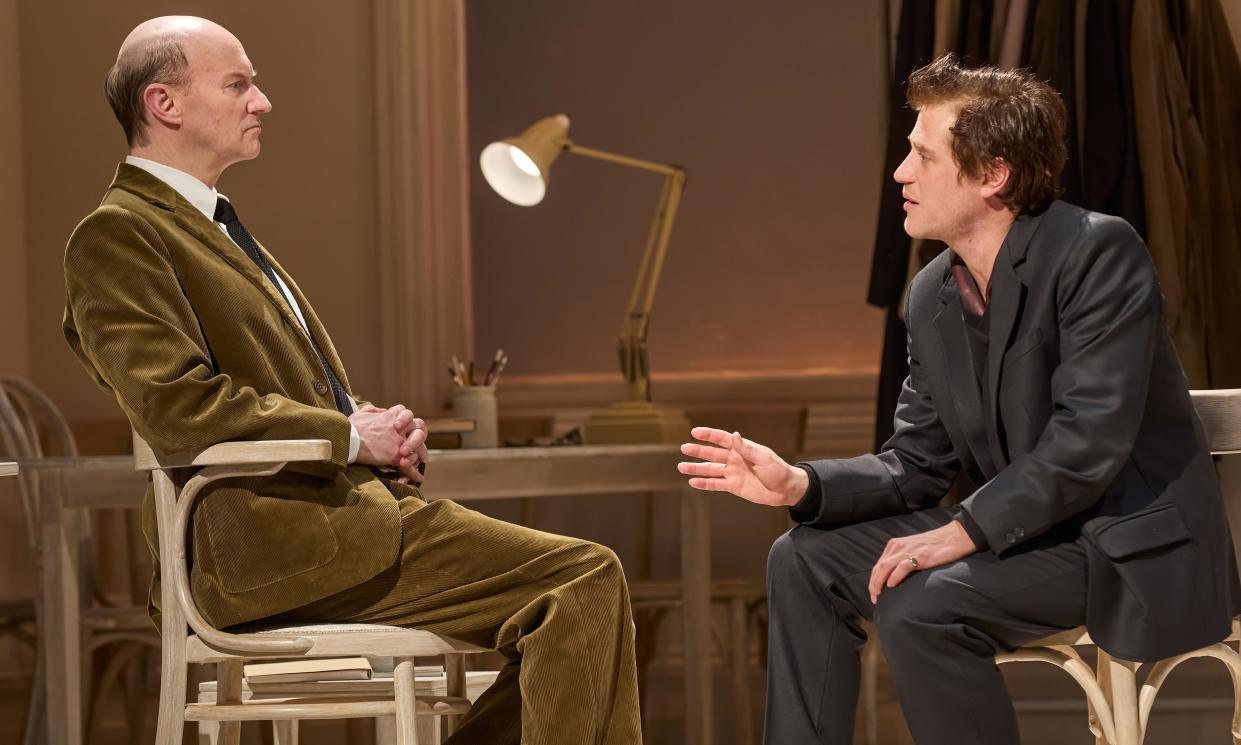The Motive and the Cue review – Gielgud and Burton battle it out

In 1964, John Gielgud directed a stripped-back Broadway production of Hamlet, performed as if it was a final rehearsal, with nothing to distract the audience from the play’s celebrity casting of Richard Burton.
In Jack Thorne’s dramatisation of the pair’s encounter, Mark Gatiss plays Gielgud, whose star is fading, and Johnny Flynn plays Burton, whose star wattage has shot off the scale after his recent marriage to Elizabeth Taylor (Tuppence Middleton). It is Taylor who speaks of the potential for fireworks in this prickly partnership between a “classicist wanting to be modern, and a modern wanting to be a classicist”.
Those fireworks take some time to explode in Sam Mendes’s attractive but slightly anaemic production, which splices ego-bound battles between the men with scenes from Hamlet, some of which are evocatively staged. But the proxy father-son psychodrama between the two remains undercharged for too long and is then resolved too neatly.
Burton and Taylor’s relationship does not set the stage alight either. Middleton plays the part too lightly, rather like a turn in a TV sitcom, emanating none of the smouldering charisma of her real-life counterpart. Flynn does an energetic impression of Burton, hitting all the Welsh inflections and tonality of his speech patterns, but it remains an impersonation.
Where the play comes alive is in Gielgud’s story and Gatiss’s performance. He sounds like Gielgud but captures something beyond imitation: the pained spirit of a great actor grappling with the ageing process – the old guard, reluctantly, giving way to the new. Gielgud admits to his envy of Burton and shows his insecurity as a director. We see the fear his homosexuality brings in an era when it was criminalised; a hotel room conversation with a sex worker carries great, subtle power. While Gielgud’s inner complications are slowly but searingly explored, much of what surrounds him feels emotionally sterile.
It is still a polished production, with what looks like cinematic framing: text appears on a black background which opens up to sets, designed by Es Devlin, filled with flat rich swathes of colour, alongside Katrina Lindsay’s costumes, which carefully tend to period detail.
Related: Heavenly powers or something rotten? When Richard Burton played Hamlet
There are filmic “Easter eggs” too: Taylor holds a chicken drumstick and speaks of marital boredom when she first appears, presumably referencing an early scene from Who’s Afraid of Virginia Woolf? Pauses between scenes bring stylised whimsy and piano music that sometimes resembles the soundtrack to an early Woody Allen film, other times the old Hamlet cigar adverts.
But even with its cinematic elements, this is a rather self-regarding homage to theatre. “Together we share the responsibility of what theatre can be,” says Burton. “Theatre is thinking,” says Gielgud, and these observations sound close to mawkish cliches on the mythology and magic of the stage.
There is a real sense of remove too as we watch actors playing actors who, in turn, are playing characters in Hamlet, or unpicking the meanings of the play, scene by scene. Ultimately, this play-about-the-play leaves us wishing we had been there to see Burton in the real thing.
At the Lyttelton theatre, National Theatre, London, until 15 July

 Yahoo News
Yahoo News 
